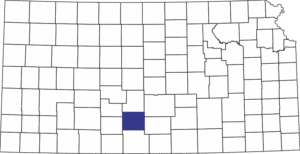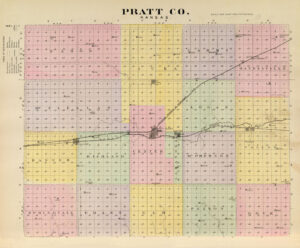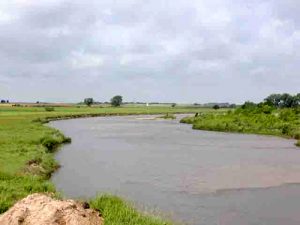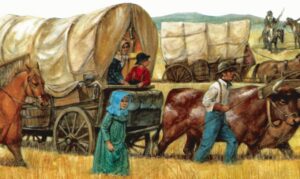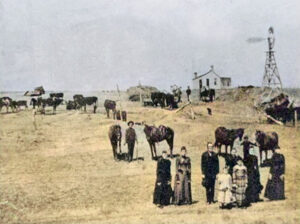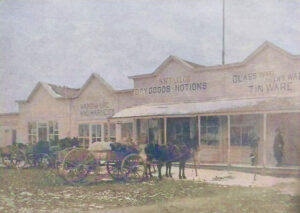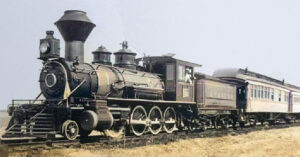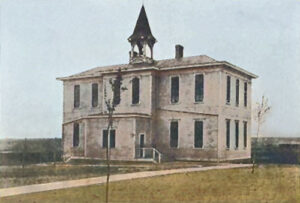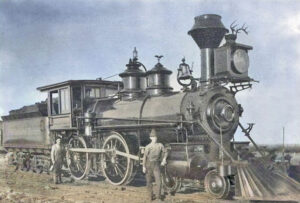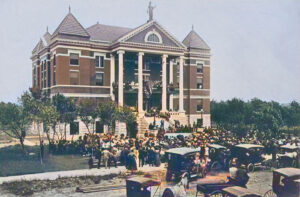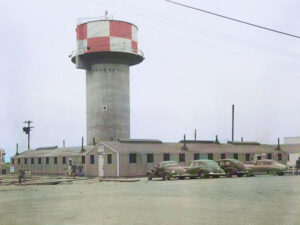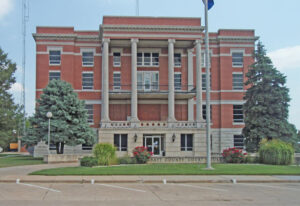Towns & Places
Byers
Coats – Extinct
Cullison – Extinct
Iuka
Pratt – County Seat
Preston – Extinct
Sawyer
Pratt Army Airfield
Pratt County Lake
Chikaskia River
Ninnescah River
Pratt County Photo Gallery
Pratt County, Kansas, is in the south-central part of the state. Its county seat and largest city is Pratt. As of the 2020 census, the county’s population was 9,157, and it has a total area of 736 square miles, comprising 735 square miles of land and 1.0 square miles of water. The county was named for Caleb Pratt of the First Kansas Infantry, who died in the Battle of Wilson’s Creek, Missouri, during the Civil War, and who had previously been involved in the Bleeding Kansas era.
Pratt County is the second county from the state’s southern border and the seventh from its western border. It is bounded on the north by Stafford County, on the east by Reno and Kingman, on the south by Barber County, and on the west by Kiowa and Edwards Counties. Iuka, the first county seat, was 180 miles east of the western line of the state and 220 miles west of the eastern line. It contained 460,800 acres, equivalent to 720 square miles.
The greater portion of the county was a beautiful, rolling prairie, with many portions being relatively level and tillable. This description of the surface, however, does not apply to the northern portion of the county, as the north tier of townships was quite rough and broken, except for a tract in the extreme northwest, which was excellent farming land. This rough strip in the north was a succession of sand knolls, some much higher and larger than others, but all huge piles of shifting sand. On the west side of the county, north of the center, there is a strip of sand hills approximately five miles wide and eight miles long, which is exceedingly rough. Bottomlands averaged one-fourth to one mile in width and comprised about 8% of the area.
Thin belts of timber lined the streams. The Ninnescah River originated in the central part of the county and flowed east. The Chikaskia River originated in the south and flowed southeast into Barber County. Gypsum and sandstone were found in the south and southwest.
Pratt County was established in 1867.
The county’s first attempt at organization, termed the “fraudulent organization,” occurred in 1873. A group from Hutchinson, Kansas, traveled through various counties, organizing them as they went. That year, they completed the organization of the county, issued bonds, and elected a nonentity to the legislature. However, because there were no bona fide settlers in Pratt County at the time, the organization was required to submit false statements to the governor. This fraudulent attempt was not recognized.
The first actual settler was A.J. Johnson, who was located in the vicinity of Springvale, in the southwest corner of the county, in the fall of 1873. He cultivated the county’s first crops. J.W. Black and A. Kelly were the next to settle in the county, both located in the southwest corner.
One of the notable characters of the early period was “Skunk” Johnson, who in 1874 selected a site at the headwaters of the Ninnescah River, where he built a dugout that became known as “Skunk” Johnson’s Cave and remained one of the county’s curiosities for a long time. At one time, Johnson was besieged by the Indians in this cave for 15 days, during which time he killed several of them. It was said that during the siege, he subsisted on skunks. After Johnson left, it became a favorite camping place for freighters.
I.M. Powell was the next to settle in the same vicinity in September 1875.
Although the settlers in the county in 1876 were exceedingly few and confined, chiefly to the southwest corner of the county, they did not get along altogether peaceably. A. Kelly, who came to the county with J.W. Black early in 1874, boarded with the latter’s family and owed him about $75 for board. Kelly was preparing to advance his claim and had built a small house thereon. When the house was finished, Black took possession of it for the board money owed by Kelly. The latter ordered Black to surrender and quit the premises when Black told him he could have possession when he paid his board bill, whereupon Kelly drew his revolver and shot Black, killing him instantly, and Kelly immediately fled the county.
However, 1877 saw a significant influx of settlers. Early in the spring of that year, several newcomers were located in the northeast corner of the county, with two men named Haynes among the first. During the summer of that year, a large settlement from Iowa relocated to what was then the county’s center, where they filed claims and established the town of Iuka. With the colony came Robert Anderson, J.W. Ellis, Reverend A. Axline, Eugene Ellis, Charles Dunn, Dr. Greenleaf, Fred Frazee, A.W. Ellis, John Stephens, Dr. Hughes, R.T. Peak, Mrs. Spruill, J.W. Byerly, O.L. Peak, Miss Annie Risley, Clyde McCann, and Charles Abbott, who were followed that same year by large numbers of people from Davis, Appanoose and Van Buren Counties, Iowa. This, virtually, was the commencement of the real settlement of the county. More than 100 families settled in the county in 1877, most of whom came from Iowa, but this was no comparison to the settlement that occurred the following year.
More settlers came in 1878 from all sections of the United States, keeping land office officials busy with pre-emption claims. The abundant crops of that year significantly increased immigration. That year, the first newspaper in Pratt County, the Pratt County Press, was established by M.C. Davis and J.B. King. The first school in the county was taught in Iuka that year by Miss Laura Long, whose wages were paid through private subscription. The bogus organization was disbanded in the fall of 1878.
The Pratt County Press was established in August 1878 by M.C. Davis and J.B. King.
In the spring of 1879, the citizens petitioned the governor for reorganization. A census taker was appointed and, upon receiving the returns, found that there were sufficient inhabitants to justify the establishment of a legitimate organization. Governor John P. St. John issued a proclamation organizing Pratt County, with Iuka as the temporary county seat and the following temporary officers: County clerk L.C. Thompson; commissioners John Sillin, Thomas Goodwin, and L.H. Naron. The election was held on 2, when the following officers were elected: County clerk, L.C. Thompson; clerk of the district court, Samuel Brumsey; probate judge, James Neely; treasurer, R.T. Peak; sheriff, Samuel McAvoy; county attorney, M.G. Barney; superintendent of public instruction, A.H. Hubbs; register of deeds, Phillip Haines; surveyor, J.W. Ellis; coroner, P. Small; commissioners, John Sillin, L.H. Naron and Thomas Goodwin.
The county was divided into 18 townships: Banner, Carmi, Center, Elm, Gove, Grant, Haynesville, Iuka, Lincoln, Logan, McClellan, McPherson, Naron, Paxon, Richland, Saratoga, Springvale, and Valley. The post offices are Caro, Coats, Croft, Cullison, Iuka, Lawndale, Olympia, Pratt, Preston, and Sawyer. A branch of the Atchison.
For the county seat, a special election was scheduled on September 2, 1879. There were three candidates: Saratoga, Iuka, and Anderson. In the lead-up to that election, a proponent of Saratoga named W.F. Gibbons made a deal with W.H. Weidner from Medicine Lodge, agreeing to pay him $40 to bring about 15 cowboys into Pratt County 30 days before the election to vote for Saratoga. Each cowboy was promised $5, free whisky, and a free dance at Saratoga on the night of the election. Weidner located the cowboys and provided Gibbons with a list of names, as agreed, in exchange for $25 as part payment. However, due to a contract dispute, all the cowboys left Pratt County before the election, causing Saratoga to lose their intended votes. Iuka was ultimately declared the county seat with a significant majority. However, this caused such dissatisfaction that a recount was conducted, including the votes previously discarded. No candidate then had the majority, and a new election was ordered. Anderson withdrew.
Despite a prosperous crop period in 1879 and 1880, many settlers departed in subsequent years, while others arrived in large numbers, particularly in 1882. During the county’s early years, owing to the scarcity of lumber, many constructed sod houses or dugouts.
In the spring of 1880, J.B. King retired, leaving M.C. Davis as the sole editor and proprietor of the Pratt County Press. He ran it until November 1880, when he sold it to B.F. Lane and A. S. Thomson.
The next election was held on August 19, 1880. An attempt by Saratoga to buy votes became public before the election; Iuka received an overwhelming majority and was declared the permanent county seat. County officials were also found guilty of defrauding the county by issuing illegal scrip. In the two years after the county was organized, it had taken nearly $75,000, or about $40 per man, woman, and child in the county. They were prosecuted, and new officers were elected.
The Atchison, Topeka & Santa Fe Railroad, which ran west from Wichita, entered on the eastern border and terminated at Pratt. Another line of the same road entered the southeast and crossed the southern part of the county, running west into Kiowa County, with a branch south from Springdale into Barber County. The Chicago, Rock Island, and Pacific Railroad entered the northeast and crossed southwest to Pratt, then into Kiowa County. A branch of the Missouri Pacific entered the northeast and terminated at Iuka.
In May 1881, B.F. Lane sold his interest in the Pratt County Press to H.P. Cooper, after which it was published under the firm name of Cooper & Thomson. In September, Cooper parted with his interest with Thomson. The newspaper was a seven-column folio, Republican in politics, and had a circulation of about 300.
In 1881, the school population of the county, comprising children between the ages of five and 21 years, was 365, of which females outnumbered males by five.
In 1882, there were 21 organized school districts in the county and only eight school buildings, the greater portion of them being built of sods. Some of these sod schoolhouses are pretty comfortable, with plaster interiors and reasonably well-furnished with seats and benches. In some districts, schools were held in private homes. The great difficulty in obtaining materials for construction was one reason the school buildings are not of higher quality.
At that time, the school population had increased to 506, a 141-person increase in one year, indicating a significant increase in the county’s population. The increase was about evenly divided between males and females, with 249 males and 257 females.
That year, 15 districts sustained public schools for three months or more, and 6 failed to sustain a school for three months or more. The assessed valuation of the county per school district in 1882 was $7,141, and the number of mills levied for school purposes was 15. The school bond indebtedness was $1,591, and the estimated value of school property in the county was $2,416.
The Pratt County Times was established in October 1881 by H.P. Cooper, with C.T. Warren as editor and publisher. In September 1882, Mr. Warren purchased the paper and became its sole editor and proprietor; the paper continues to be published under his leadership. The paper was a five-column quarto, Republican in politics, and had a circulation of about 500.
Excepting two flouring mills, there were no manufactories of any kind in the county. One of the flouring mills was located at Springvale, in the southwest corner of the county, a little south of the headwaters of Turkey Creek. It was a small water mill with two stone runs, built by Johnson & Stiles in 1879 at a cost of $10,000. The other mill was located in Iuka and was erected in 1883 by Knapp, Casebolt & Co. It was operated by steam power and had four runs of buhrs. The building was 30 feet by 60 feet and three stories high, valued at $12,000.
In 1882, approximately 16,000 acres of land were under cultivation. In 1910, the acreage was 371,041, and the value of farm products was $5,279,294. Corn, the largest field crop, brought $1,693,629; tame grasses, $357,943; wild grasses, $256,925; oats, $174,773. The animals sold for slaughter brought $2,196,761; poultry and eggs, $162,266.
Efforts to relocate the county seat to Pratt commenced in 1885. That fall, another county seat election took place. The candidates were Iuka, Saratoga, and Pratt. It was one of the most bitterly contested county-seat elections in the state’s history. Saratoga had 546 votes and Pratt 324. Because the total number of voters in Saratoga was only 200, allegations of fraud arose, and the commissioners sustained the charges, declaring Pratt the county seat. The matter was taken to court, and, pending the decision, emotions ran high.
The Saratoga and Pratt partisans were all armed, and trouble was expected. The Pratt men went to Iuka and forcibly removed the county records. On the way back, they were attacked by the Saratoga men, who captured the treasurer’s safe and carried it to their town. The next day, Saratoga launched an attack on Pratt in a fruitless effort to acquire the other county’s property. By this time, the more peaceable citizens asked the governor to send a militia to restore order.
Governor Alexander Martin sent Adjutant General Campbell and Colonel W.F. Hutchinson to the county. They stationed guards at both towns and prohibited anyone from carrying arms. Finally, the Supreme Court handed down its decision and ordered the records to be returned to Iuka. Matters quieted down, but the county seat contest was not yet forgotten.
On January 6, 1886, a devastating blizzard was the worst in the county’s history. An estimated 80% of the cattle froze to death, along with a large number of residents of the county.
In 1887, the Chicago, Kansas, and Nebraska Railway extended its main line from Herington to Pratt. This main line connected Herington, Ramona, Tampa, Durham, Waldeck, Canton, Galva, McPherson, Groveland, Inman, Medora, Hutchinson, Whiteside, Partridge, Arlington, Langdon, Turon, Preston, Natrona, and Pratt. In 1888, this main line was extended to Liberal. Later, this line was extended to Tucumcari, New Mexico, and El Paso, Texas. This line was known as the “Golden State Limited.”
Pratt’s effort to relocate the county seat succeeded in 1888 despite Saratoga’s objections.
In February 1888, a petition was presented to the commissioners asking for a special election to relocate the county seat. The election was held on February 29 of that year, and Pratt was the winning candidate. The question was finally settled. The court was housed in the People’s Bank on Main Street.
By 1890, the county’s population had increased to 8,118.
During the difficult 1890s, the population declined, and by 1900 it had reached 7,085.
The Pratt County Courthouse was built in Pratt, Kansas, between 1909 and 1910 for $101,399. Built in the Classical Revival style, it was designed by George P. Washburn & Sons of Ottawa and constructed by Randall & Smith. Facing west, the four-story, red brick, limestone, and concrete structure is situated on spacious, landscaped grounds in the center of Pratt. The west front has a large porch supported by four columns, which rise from the second story to the fourth story. The first story is faced with white limestone. There are balconies on the second and third stories. The building houses the County District Court of the 30th Judicial District.
The year 1910 was not a banner year in Pratt County, but she still raised 2,682,144 bushels of winter wheat, for which she received $2,387,108.16. The total value of the farm products was approximately $3,194,098. This amount did not include poultry, eggs, butter, animals slaughtered and sold for slaughter, and income from all other sources, which combined bring the total receipts up to $3,587,393.91. This was an excellent showing for a county with a population of a little over 10,000.
On June 6, 1923, the roof and top two floors of the courthouse were destroyed by fire, believed to have been caused by a lightning strike. The brick and stone exterior walls were deemed structurally sound, and A.R. Mann of Hutchinson was hired as the architect to rebuild at an estimated cost of $50,000 to $60,000. It is located at 300 South Ninnescah Street at the intersection of East 3rd Street.
During World War II, Pratt Army Airfield trained, processed, and housed B-29s and their crews before they were sent to war.
Pratt County’s population reached its peak at 13,312 in 1930.
Farming remains important to the county, which is among the state’s leading producers of winter wheat.
Today, Pratt County is served by Pratt USD 382 in Pratt, Kansas, and Skyline USD 438, headquartered two miles west of Pratt. Pratt Community College is also in the city.
©Kathy Alexander/Legends of Kansas, July 2025.
Also See:
Sources:
American Courthouses
Blackmar, Frank W.; Kansas: A Cyclopedia of State History, Vol I; Standard Publishing Company, Chicago, IL 1912.
Cutler, William G.; History of Kansas; A. T. Andreas, Chicago, IL, 1883.
Pratt Commercial Club; Chronicles of Pratt and Pratt County, Kansas; Pratt County Historical Society, 1911.
Wikipedia


